Abstract
Temperature-control loads, such as residential air conditioners (ACs) and electric water heaters (EWHs), have become important demand response resources in the power system. However, due to the impact of various factors on users’ response behavior, it has been difficult for power grid operators to accurately evaluate the response potential under complex factor relationships to derive optimal incentive strategy. Therefore, it cannot achieve a win-win economic benefit between the grid and users. In this paper, a method combining Analytic Network Process (ANP) and Fuzzy logical inference is proposed to predict the user’s willingness firstly by taking residential AC load as an example. The weight of each factor affecting users’ willingness is analyzed, and main factors are selected as inputs of fuzzy logic inference to derive the willingness of the resident to actively regulate the AC. Then, this method is applied in evaluating the response potential of certain residential area in Beijing according to the survey. By further considering users’ house size and the sacrificed comfort temperature under the incentive strategy, the power potential curve of the AC load under different incentives is obtained by using the first-order equivalent thermal parameter (ETP) model and the regulation willingness. Finally, with the objective of maximizing the consumption of the photovoltaic (PV) power, the optimal operation is achieved through the coordinated regulation of residential ACs and EWHs based on the potential curve, and the corresponding optimal incentive strategy for the flexible temperature-control loads is obtained. Simulation results show that the optimal incentive strategy proposed not only increases the PV consumption ratio to 98.35% with an increase of 24.71%, but also maximizes the economic benefits of both sides of the power grid and users. This method of deriving incentive strategy can be used as a reference for grid companies to formulate the incentive strategy to realize optimal operation, such as the maximum new energy consumption.
1. Introduction
Residential temperature-control load is an important part of the demand response (DR) on the user side with large regulation potential, and it will play an important role in promoting the consumption of new energy in the power system [1,2,3]. However, there are various factors affecting a user’s willingness and behavior to regulate the temperature-control load represented by residential ACs and EWHs, and it is difficult to predict and evaluate the power potential of the temperature-control load correspondingly [4]. It is also hard for power grid operators to formulate incentive strategies to stimulate the potential of the temperature-control load to realize the optimal operation due to complex factor relationships [5,6]. Therefore, when the power grid operator determines the dispatching plan one day ago, it needs to comprehensively evaluate the response willingness of regional residents to the temperature-control load and the adjustable potential, so as to formulate reasonable incentive measures. The purpose of evaluating response potential is to realize the optimal operation to bring “win-win” economic benefits to grid operators and residential users and obtain the corresponding incentive strategies. Multi-objectives of the optimal operation can be realized including increasing the consumption of the PV, reducing the operation cost of power grid through ‘peak shaving and valley filling’, enhancing the stability and flexibility of local distribution network, and improving energy utilization efficiency.
When the temperature-control load participates in DR for PV consumption, it is necessary to establish a potential evaluation model of the aggregated load in advance for aggregators to bid and formulate dispatching plans [7,8,9,10]. Taking resident AC load as an example, literature [11] established an evaluation model of response potential of the AC load considering the multiple factors comprehensively, such as thermal comfort, willingness, and controllability of users. However, it only considered user willingness model with impact factors of the electricity charge and user family background information including family income, education level and age, etc.; it did not relate the users’ willingness with the potential, that is, how much flexible load could be used for the optimal operation. In addition, it lacked incentive measures for grid operators to realize the optimal operation in different scenarios. Literature [12] established an AC integrated control model by considering factors, such as periodic temperature change, users’ willingness to participate in DR response, and it related those factors with the dispatch potential. However, the user’s willingness was expressed in the form of 0-1 variable without considering the willingness elasticity and the uncertainty of corresponding response behavior.
In order to take into account the consumption of distributed new energy and the economic benefits of both the grid and user sides in the DR, an optimal incentive measure needs to be established. Literature [13] proposed a user response behavior prediction model based on the long-short term memory (LSTM) network by using equal gradient iterative learning incentive strategy. It gave different incentives to users with different response characteristics and reduced the overall incentive cost. After analyzing the reason for abandoning the wind-power, literature [14] suggested the application of a wind-power consumption resource pool to adjust price to promote the local consumption of the wind. The wind-power consumption had been improved by coordinating the wind and fire power generation and distributing benefits reasonably between them. Literature [15] also proposed the idea of wind-power bundling to realize wind-fire cooperation and provided the optimal solution to the benefit distribution between them. Although above research provided measures to formulate incentive strategies from either the user or the new energy sides, they did not evaluate the potential of the flexible load and coordinate the potential with the new energy. Therefore, they did not apply to all optimal operation scenarios.
On the basis of above research, this paper focuses on the temperature-control load represented by residential ACs and EWHs. Through questionnaires, the transfer and usage characteristics of two kinds of loads have been studied under complex relationships. Through optimizing the dispatch results, it deduces the optimal incentive strategy, so as to fully develop the potential of flexible loads and achieve the economic objective of maximal PV consumption. Firstly, taking the AC load as an example, a method combining analytic network process (ANP) and fuzzy logic inference is proposed to predict the willingness of active load. ANP is used to analyze the weight of each factor affecting the usage of residents’ ACs, and six main factors are selected as the inputs of fuzzy logic inference, through which the willingness of each user to actively regulate the AC under main factors is obtained, and the incentive-willingness curve can be extracted from the inference result. The relationship of incentive and user sacrificed comfort temperature can be established through the survey of 200 users in a rural residential area in Beijing, other survey data such as the user’s house size can also be obtained through the survey. Then the power potential curve of the AC load under different incentives can be derived by combining the incentive-willingness curve with survey data. There are positive and negative potential parts under positive and negative incentives based on current Time of Use (TOU) tariff to realize the objective of maximal PV consumption, such as the noon time corresponding to the positive incentive to promote the usage of PV power, and the evening time usually corresponding to the negative incentive to reduce or transfer the power usage. After the optimal operation with the PV consumption objective, the corresponding optimal incentive strategy can be derived. These flexible-load potential evaluation and optimal incentive strategy derivation methods can not only realize the optimal operation, but also give full play to the potential of flexible load. Therefore, win-win economic benefits are achieved for both the grid operator and users. Finally, the effectiveness of the proposed methods is verified by MATLAB simulation analysis.
2. ANP-Fuzzy Prediction Model
Analytic network process—Fuzzy logical inference (ANP-Fuzzy) is a comprehensive analysis method that combines ANP and Fuzzy theory. ANP divides the target and all elements affecting it into control layer and network layer. The control layer includes the target and the decision criteria. The decision criteria are independent of each other and are only dominated by the target element; the network layer is composed of all elements dominated by the control layer, and its interior is a network structure that affects each other [16]. The schematic diagram of the network hierarchy of ANP is shown in Figure 1, and the main elements that affect the target can be obtained through analysis. The Fuzzy theory is an approximation method to accurately describe fuzzy things [17]. The combination of ANP and Fuzzy can not only effectively avoid the influence of extreme values of ANP on the construction of the judgment matrix, but also describe the characteristics of uncertain things more objectively and truly. Taking residential AC load as an example, this model can be used to predict the willingness of users to actively regulate ACs and fully develop their DR potential.
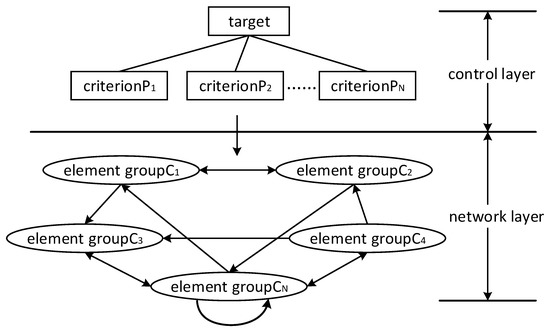
Figure 1.
Schematic diagram of the network hierarchy of ANP [16].
There are four types of factors for inputs of the ANP-Fuzzy model affecting the willingness of actively regulating ACs, which are meteorological elements, family background information, AC usage information and incentive strategies, and each factor includes multi-elements forming an element group, as shown in Table 1. After the main elements are obtained by the weight analysis of ANP, the willingness is predicted by the fuzzy inference model. In this paper, software of super decisions 3.2 is used for establishing ANP model and weight calculating, and fuzzy logic module is established in MATLAB for fuzzy logic inference.

Table 1.
Evaluation indicator system of user willingness to actively regulate AC.
2.1. Establishment of Evaluation Index System Based on ANP
The ANP target is user willingness to actively regulate ACs. All elements affecting the willingness can be divided into two sets and the ANP evaluation indicator system is shown in Table 1.
There are four grade-1 indicators for the factor set forming the decision-making criteria in the control layer. Indicators in each element group in the network layer are the refinement of decision-making criteria. Among meteorological factors, there are two grade-2 indicators including ‘daily maximum temperature’ and ‘daily average relative humidity’, and they are selected due to the greatest impact on users’ behavior to regulate the air-conditioner. The factor of ‘family background information’ not only considers the influence of ‘house size’, ‘annual family income’ and ‘age distribution of family members’, but also focuses on the influence of ‘room comfortable temperature range’ on users’ behavior to regulate the air condition. Element of ‘AC usage time’ in the ‘AC usage information’ set refers to the behavioral habits of households using AC daily, that is, using AC at morning, noon, afternoon, evening, night or the period from late night to early morning; the ‘initial willingness to use AC’ is the willingness of residents to use AC without incentives corresponding to the basic AC load, which can be obtained from load forecasting. The ‘price incentive’ element includes positive and negative incentive parts referring respectively to reduce or exempt electricity charges and increase electricity charges.
2.2. ANP-Fuzzy Implementation Steps
- Establish the 2-layer ANP network model
The model is built according to the mutual element relationships. Let the factor indicator set in the control layer in Figure 1 be , and the element indicator set in the network layer be .
- 2.
- Identify element importance and generate comparison judgment matrix
Element relative importance is identified by using 1–9 scale method, and then the comparison judgement matrix is established. The consistency level of the judgment matrix is tested by using the consistency coefficient , indicates that the weight is within the acceptable range.
- 3.
- Calculate weight vector of each element group
The weight vector of each element group in the network layer is obtained by using the eigenvalue method, that is the main eigenvector of the matrix is calculated.
- 4.
- Generate weighted supermatrix
M number unweighted supermatrix are constructed according to the impact relationship between local weight vector and . After normalization, weighted supermatrix , is obtained, and each element corresponds to a global weight.
- 5.
- Perform supermatrix stability processing
The relative ranking vector limit of each supermatrix is calculated:
If the limit is convergent and unique, the value of the corresponding row of the original matrix is the stability weight of each indicator. So far, the global weight proportion of all element indicators can be obtained, and the element with a large proportion can be analyzed and selected as the input of the fuzzy inference module.
- 6.
- Establish fuzzy inference model and perform fuzzy processing
Main element indicators are selected as inputs of the fuzzy inference model, which account for a large proportion in ANP weight analysis. The output is the willingness of residents to actively regulate air conditioners. The structure of the fuzzy logic model for predicting residents’ willingness is shown in Figure 2.

Figure 2.
Fuzzy logic model structure for prediction of residents’ willingness to actively regulate air conditioners.
The model firstly converts inputs into a fuzzy set. In order to achieve high prediction accuracy, input variables are divided into 5 fuzzy subsets: NB (Negative Big is very low/small), NS (Negative Small is low/small), O (Zero medium), PS (Positive Small is high/large), and PB (Positive Big is very high/large), the output variable of the willingness is divided into three fuzzy subsets: NB, O, and PB.
- 7.
- Construct membership function
The membership function of each input variable in this paper adopts a triangular function, and the membership function of the output variable adopts a Gaussian function. The value of the membership function is taken continuously in the interval of [0, 1].
- 8.
- Formulate fuzzy rules
In this paper, the initial fuzzy rules are obtained through statistical analysis of data obtained from the questionnaire survey, and then the fuzzy rules are finally determined through the guidance and identification of experts in the field. Fuzzy rules are formulated and revised in the form of ‘if... and... then…’.
- 9.
- Output prediction results and perform model correction
Enter the exact input variable values of a user, and then the regulation willingness can be obtained through the model. When it is found that there is a deviation between the user behavior and the model prediction, it is necessary to adjust and correct the fuzzy membership function regularly, and continuously supplement and improve the fuzzy rules.
3. Day-Ahead Dispatch Based on Price-Incentive Load Potential Assessment
3.1. Price-Based Residential Load Demand Response
Residents’ AC DR can be divided into electricity charge sensitive DR (CSDR) and incentive-based DR (IBDR) [18,19,20]. Compared with the uncertainty of CSDR’s load response, IBDR’s load response uncertainty is small, and the supply and demand balance of the power grid dispatching and regulating is rapid. However, it usually needs to sign a contract with the user and get the user’s behavior feedback through the monitoring equipment. User response behavior can be acquired through non-invasive devices, such as smart meters, or invasive sensors, controllers, and other equipment in residents’ houses. The way of direct monitoring and remote control through two-way communication networks has high cost, low efficiency, and feasibility. Therefore, this paper adopts ‘positive and negative’ incentive mode based on hourly electricity charge to stimulate the load response of users, that is, positive incentive means a reduction in original charge and vice versa. Therefore, the electricity charge is regulated in different time periods in the next day to get the full play of the flexible load potential to meet optimal operation objectives.
3.2. User Comfort Price Compensation Model
Active regulation means that residents increase or decrease the usage and transfer AC load in different time periods, that is, increase or decrease the original load, and transfer the original usage time period to other time periods. In order to encourage residential users to increase their PV consumption during the day when the PV power generation is sufficient, the grid operator needs to give user positive incentive; to stimulate users to use less or transfer the AC load during the evening load peak time, the grid operator needs to give user negative incentive. Taking the AC load as an example, the relationship between the incentive price and the sacrificed comfort temperature is shown in Figure 3. User sacrificed comfort temperature is the temperature difference between the comfort temperature accepted after and before the incentive, and it is also the temperature regulated by the AC compared to initial set temperature. When the incentive price is low, the user is insensitive to the change of electricity charge and will not actively regulate the original AC set temperature, or sacrifice the comfort; as the incentive price gradually increases until it exceeds the user’s minimum perceptible difference range, the AC load begins to respond linearly, that is, they are willing to sacrifice more comfort under a higher incentive price; when the user’s set temperature starts to go beyond the comfort zone of the human body, users will not sacrifice comfort anymore, even though the incentive price is higher. The greater the incentive, the greater the comfort the user is willing to sacrifice compared to the original comfort.
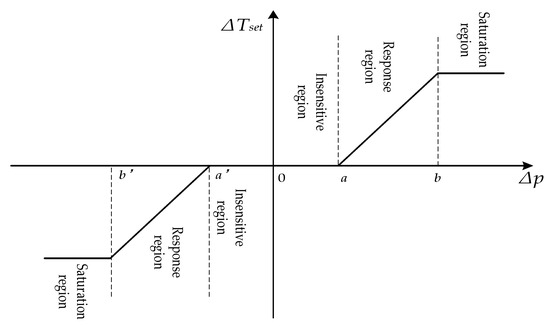
Figure 3.
Relationship between incentive price and sacrificed comfort temperature [21].
The positive incentive price to sacrificed temperature relationship can be expressed as follows:
where and respectively represent the actual regulation amount and the maximum regulation amount compared to original comfort temperature without incentives, represents the incentive price, and respectively represent threshold values of the insensitive region and the saturation region of sacrificed temperature, and is the slope of the linear response region.
Relationship between the set temperature T of air conditioner and the upper and lower limits of human comfort temperature:
where is the acceptable temperature range considering user comfort, and are the upper and lower limits of the comfort temperature of the human body, is the actual set temperature of the AC, and is the initial set temperature of the AC.
3.3. Prediction of Adjustable Power Potential of Residential AC
Taking the AC load as an example, it can be seen that the power of AC used by different users every day is affected not only by their willingness, but also by the house size and comfort they are willing to sacrifice under incentives. However, unlike commercial buildings, there is less difference in the house sizes for residential users in the community. Therefore, this paper divides house sizes into three categories: large room, medium room, and small room. Rooms with different sizes have different heat capacities. The larger the heat capacity, the larger the room size. The indoor and outdoor heat exchange process of an air-conditioned room can be characterized by the first-order equivalent thermal parameters (ETP) [22], as shown in Equation (6). The relationship between the cooling capacity of the AC load and the electric power can be expressed by Equation (7).
where and represent the indoor temperature in the t + 1 period and the t period, respectively; and represent the outdoor temperature in the t + 1 period and the t period, respectively; is the cooling capacity of AC load in the t period; R is the equivalent thermal resistance of the room; C is the equivalent heat capacity of the room; is the simulation step size, from 5 s to 1 min; is AC load in the t period; is the AC efficiency ratio of the refrigeration energy. Generally, is a fixed value for the fixed-frequency AC, and will change with for the variable-frequency AC as shown in Equation (8), a, b and c are the correlation coefficients.
A power control strategy of variable-frequency AC compressor during refrigeration period is as follows [23]:
where and respectively represent the maximum and minimum operating power of the variable-frequency AC compressor; , and are preset values; is the indoor air temperature in the t period; is the set value of AC temperature; is the temperature difference between the indoor temperature and the set temperature of the AC in the t period.
When t = 0, is the initial indoor temperature value, and the initial temperature difference can be calculated by substituting it into Equation (10), and the initial output power of the AC can be calculated by using Equation (9). Use Equation (8) to calculate the initial value of , and then calculate the initial cooling capacity of the AC by using Equation (7). Substitute into the Equation (6), the indoor next moment temperature value can be obtained by combining the room equivalent thermal resistance R, room equivalent heat capacity C, indoor initial temperature , outdoor current temperature value and outdoor next moment temperature value . Substitute into equation (10), and use Equations (6)–(10) to iteratively calculate the indoor temperature value. When the indoor temperature value drops to a certain set temperature value, it jumps out of the calculation cycle and the AC is turned off.
Assuming that the initial outdoor temperature is 30 °C, the indoor temperature is 26 °C, and the set temperature of the air conditioner is 23 °C, it can be known that = 3 °C. In addition, set the and of the AC to be 0.9 kW and 0.55 kW respectively, and a, b, and c to be −0.3276, 3.3782, and 0.1699 respectively. When the indoor air temperature drops to 1 degree below the set temperature value of the AC, the AC runs at the lowest power and keeps it for a period of time, that is, = −1 °C. AC stops running when the indoor air temperature drops to 2 °C below the set temperature of the AC, that is, when = −2 °C. Using Equations (6)–(10) and parameters in Table 2, the simulation step is set to 1 min, and the cooling power of the air conditioner compressor output in each time period can be calculated for the large, medium, and small rooms, as shown in Figure 4.

Table 2.
First order thermal model parameters.
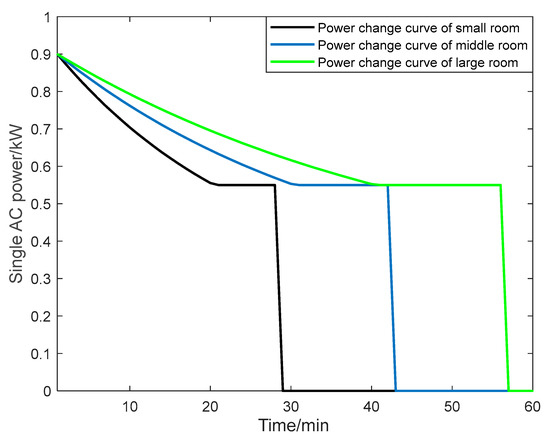
Figure 4.
Power curve of single air conditioner in class 3 rooms.
It can be seen that when the house size, R and C are known, then the power is a function of the temperature difference. Due to limited heat storage capacity of residential houses, the cooling of 3 °C is completed within 1 h for all kinds of rooms, the small room takes 29 min, the medium room takes 43 min, and the large room takes 57 min. It can be seen that the transfer ability of residents’ AC load is limited. The dynamic heat exchange model of the EWH is similar to the ETP model, however the load transfer capacity of the EWH is larger due to its heat storage ability, which can be used in advance up to 12 h to transfer the peak load and improve the PV consumption in the afternoon. This paper does not consider the difference of EWHs for each household, and they are seen as a 3 kW load.
After knowing the temperature difference under incentives and room size, output power of the temperature-control load of a single household can be derived according to above calculation. By multiplying the output power with the regulation willingness of a single household under different incentives, the power potential of a single household can be derived. The power potential actually considers the uncertainty of temperature-control load, that is, not full power can be used in real life due to uncertainly of user behavior. Then the total output power of temperature-control loads in the community can be known by superposing all power potential of a single household.
3.4. Day Ahead Dispatching Model of Power System
National ‘county PV’ project constructs large-scale of distributed rooftop PVs in residential areas, and there are two kinds of electricity charges for distributed PV power generation in residential areas: charge of ‘unified purchase and sale’, and charge of ‘spontaneous self-use’. Taking the charge of ‘unified purchase and sale’ as an example, the collected distributed PV power generation can be regarded as a virtual PV power station. PV had better be consumed on-site for considering the grid economy and safety.
In the summer day-ahead market, operators need to formulate the incentive price according to user’s response potential to realize the optimal objective, such as the maximal PV consumption. User’s AC power consumption in the evening is transferred due to the negative incentive, since the evening time usually corresponds to load peak and the PV power generated is small. Due to limited house capacity, the transferred AC load is used usually 1 to 2 h ahead for pre-conditioning. At the same time, AC load is encouraged to be used by the positive incentive as much as possible during the daytime, especially at the noon time.
In order to maximize the PV consumption, the objective function is:
where is the output value of the PV power in the t period, is the residential load in the t period, is the transfer load transferred from other periods to the t period, and is the daytime period that the PV output in the residential area is greater than the load. In the objective function, and are predicted day-ahead. The transfer load in the t period after the response is:
where is the load transferred to the t period; is the load transfer rate; is the total transferred load in all time periods; status indicator represents the user’s execution status expressed by the binary number, 1 indicates that the load has been transferred to the t period, and 0 indicates that the load has not been transferred to the t period; is the initial load of the transfer period; is the full-time load after response; is the set of all time periods for optimization of bidding decision. 24 time periods are set in this paper, and each time period is 1 h.
The load regulation constraints are:
Equations (14) and (15) are the maximum and minimum transfer time constraints for residential ACs and EWHs, respectively, where and represent the upper and lower limits of the transfer time, respectively, and and are the start and end indexes of regulation, respectively, represented by binary 1 and 0; Equation (16) is the operating state constraint; Equation (17) stipulates that it cannot start and end at the same time in one period; Equation (18) indicates that the load can only be transferred from the period to other periods; Equation (19)) indicates that the total power consumption of the load after regulation cannot exceed the maximum output value of PVs during the period. The model is a mixed integer linear programming model, and the decision variables are , , and , and the CPLEX solver is called in MATLAB through the YALMIP toolbox to solve the calculation.
4. Case Analysis
This paper takes a rural residential area in Beijing as the research background. 200 households in this rural residential area have distributed PV power generation equipment on their roofs. PV power generation participates in DR in the form of ‘unified purchase and sale’. Since the distributed roof PV output power in this area is greater than the electricity consumption in the daytime, and there is no electricity generation at night, the PV power generation in the daytime is free, and the electricity needs to be purchased from the power grid at night, the focus of this paper is to guide users to increase temperature-control loads at daytime to consume PV energy, and transfer or reduce temperature-control loads at nighttime through incentives. Compared to reducing loads, transferring loads is prefer due to its consideration of user comfort.
4.1. Using ANP-Fuzzy Model to Predict Residents’ Willingness to Actively Regulate AC
Through a questionnaire survey of 200 households, the ANP network structure model is established, which is shown in Figure 5 to include 4 grade-1 factors and 11 grade-2 elements affecting households’ active regulation of ACs. The local and global weights of each grade-2 indicator are shown in Table 3. Since the limit of each global weight is convergent and unique, it is also a stable value.
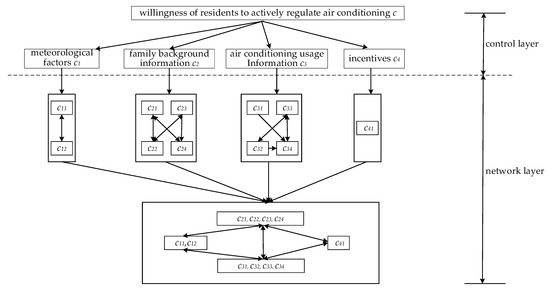
Figure 5.
ANP structural model of residents’ willingness to actively regulate air conditioners.

Table 3.
Local weight and global stability weight of ANP grade-2 indicator.
There are six grade-2 indicators including ‘daily maximum temperature, daily average relative humidity, room comfort temperature range, AC usage time period, initial willingness to use ACs and incentive price’ with large global stability weight values in Table 3. They are taken as inputs of the fuzzy inference model, and the output is the residents’ willingness to actively regulate the AC. Fuzzy rules are formulated by the collected questionnaire data and expert guidance.
Taken the prediction of the willingness to actively regulate AC of one user as an example, 6 inputs for Fuzzy inference are shown in Table 4. Figure 6 shows the relationship graph of the output willingness with the daily maximum temperature and incentives. Three ‘incentives to willingness’ curves when the daily maximum temperature has certain values of 28, 34, and 38 °C are shown in Figure 7.

Table 4.
6 inputs of the Fuzzy logic inference.
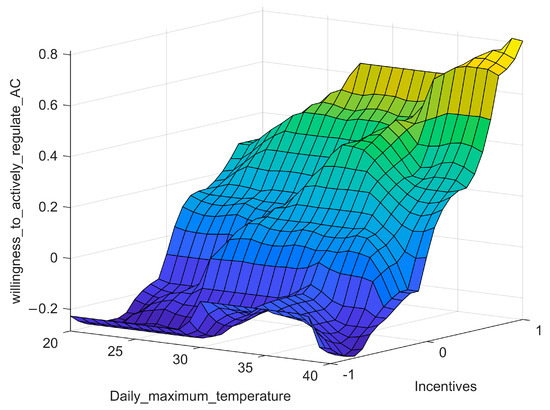
Figure 6.
Surface graph of the relationship between output and inputs.
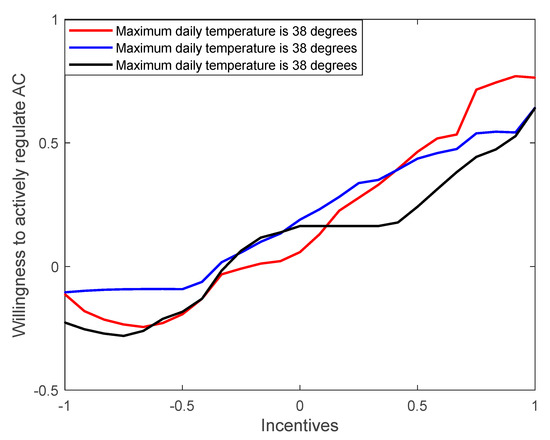
Figure 7.
Change curve of willingness of AC active regulation with incentives.
It can be seen from Figure 7 that when there is no incentive, users’ willingness to actively regulate AC is low; with the continuous increase of incentives, users’ willingness to actively regulate AC also continues to rise until it reaches the maximum value. When the negative incentive is small, user’s willingness to regulate the AC decreases continuously until zero; as the negative incentive continues to increase, users’ willingness to regulate the AC increases in a negative direction until saturation. When the daily maximum temperature is different, the curve of user’s willingness also has slight differences. When the daily maximum temperature is 38 °C, user has the greatest positive willingness to regulate. In order to consume the extra PVs in residential areas, the summer daytime hours are generally set to positive incentive periods to encourage residents to use air conditioners more; the summer evening peak hours are set to negative incentive periods to guide residents to use less electricity.
4.2. Prediction of Adjustable Power Potential of Residential ACs
Under electricity price incentives, users are willing to sacrifice a certain degree of comfort to transfer the AC usage demand at evening to the afternoon for pre-cooling, or reduce the usage of air-conditioning in the evening peak; users are willing to use more ACs in the noon under positive incentives. According to the survey, the comfortable temperature range of 200 residential rooms is 23–27 °C, however, under certain price incentive, some users are willing to bear higher or lower temperature, and the range is extended to 21–29 °C. Therefore, no matter what the ambient temperature is in the summer evening, some air conditioners only need to be regulated to 29 °C to stop working other than 27 °C. Of course, the comfort zone of each user is willing to regulate is different.
According to the survey, the relationship between incentives and user sacrificed comfort temperature can be obtained shown in Figure 8. Figure 9 shows outdoor and indoor temperatures of a summer day, where the outdoor temperature is obtained the weather forecast and the indoor temperature is calculated from the original load without incentives using the ETP model. Combine temperature difference in Figure 9 with data in Figure 8, and then use the ETP model of Equations (6)–(10) to calculate, the maximal AC power potential of a single user can be obtained. However, there is uncertainty for ua ser’s actual usage, that is, the potential is a probability value. In this paper, the flow chart of getting the regulation power potential of 200 residential ACs is shown in Figure 10. Multiply the willingness curve obtained by the ANP-Fuzzy model with the maximal power potential of a single user will obtain a probabilistic potential, considering the uncertainty. Finally, the total power potential is obtained after superposing all probabilistic potentials, which is shown in Figure 11. In this figure, the absolute value of the potential is larger, its probability to be used is larger.
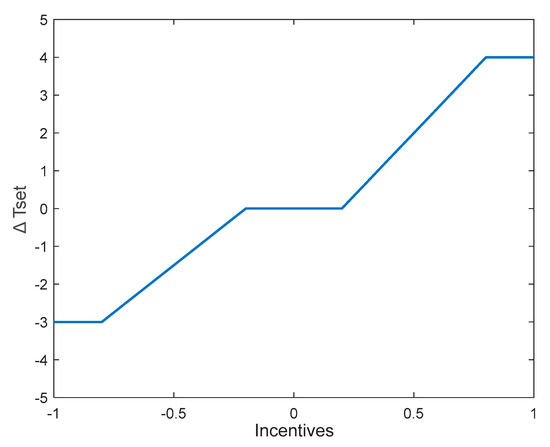
Figure 8.
User sacrificed comfort temperature under different incentives.
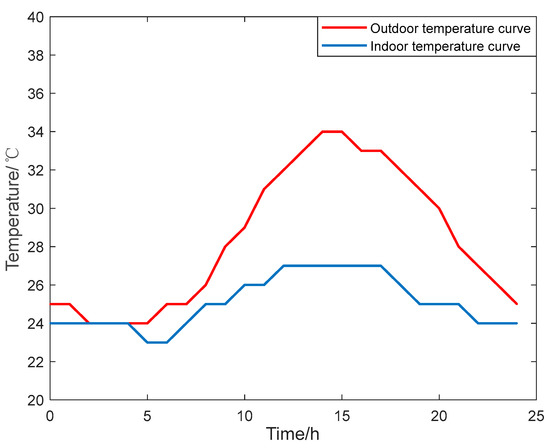
Figure 9.
Outdoor and indoor temperature curves.
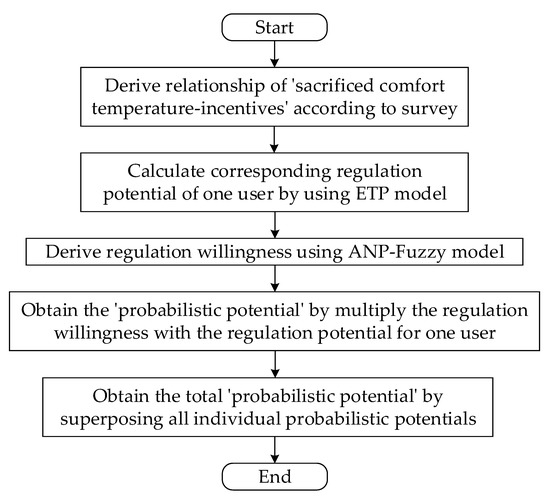
Figure 10.
Flow chart of regulation power potential curve of residential AC.
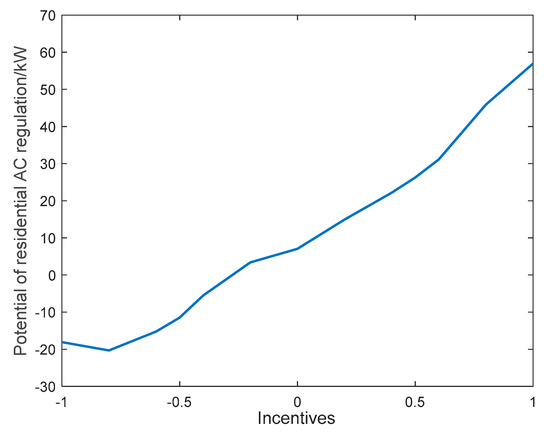
Figure 11.
AC control potential of 200 households.
4.3. Day Ahead Dispatching Model of Power System
Different incentives correspond to different responses. Figure 12 shows one incentive strategy. Under this incentive, the regulated AC load after superposing the initial load with the potential of 200 users is shown as a green curve in Figure 13. We can see from the figure that the load is increased at noon time and decreased at evening time due to positive and negative incentives, however, this incentive strategy may not be the optimal incentive to realize the optimal operation. This paper proposes a method of deducing the optimal incentive through the optimal operation when the load potential is fully developed.
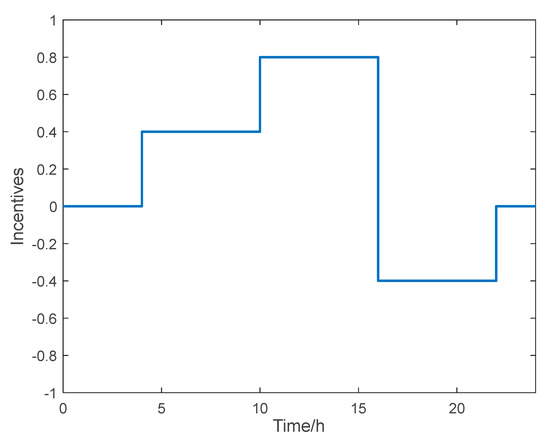
Figure 12.
Initial incentives in different time periods.
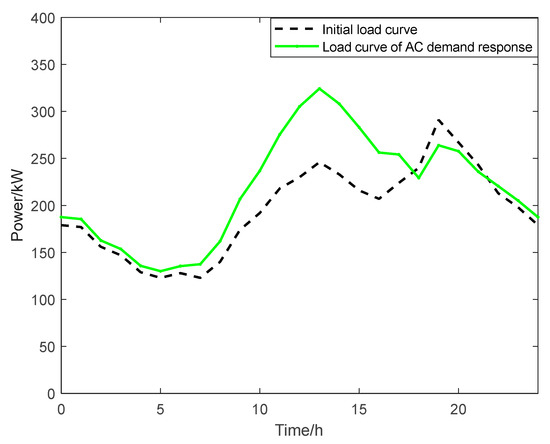
Figure 13.
Load curve of residential AC demand response.
If only the load transfer regulation of the residential AC is carried out, its regulation potential cannot reach the optimal objective of maximizing the consumption of PVs during the day due to limited heat capacities of residential rooms. Therefore, this paper selects both the residential ACs and the EWHs with the function of heat storage for coordinated regulation.
For the AC load, it is transferred from time period of 17–22 to the 15–20 time period under incentives. However, for the EWH load, it is transferred from time period of 18–24 to the 8–16 time period under incentives. The transfer time range for the AC load is 0.5–2 h, it is 8–10 h for the EWH load. The maximum load transferred per hour of the AC load is shown in Figure 11 with the value of 60 kW, and the maximum load transferred per hour of the EWH load is 70 kW. The optimal operation results are shown in Figure 14, Figure 15, Figure 16 and Figure 17.
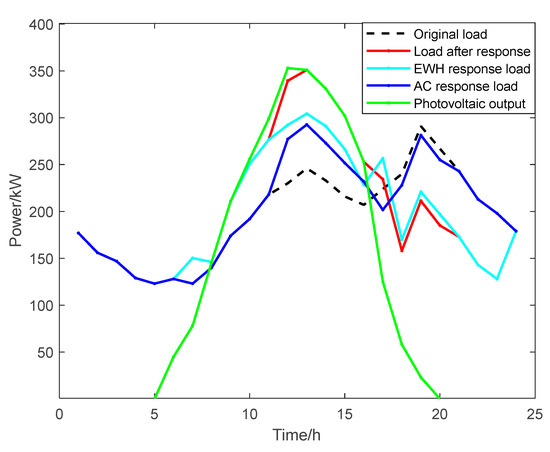
Figure 14.
Dispatching control results of residential temperature-control load.
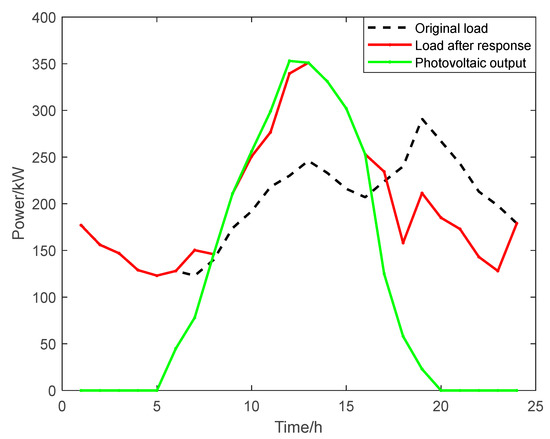
Figure 15.
Photovoltaic consumption effect after temperature control load demand response.
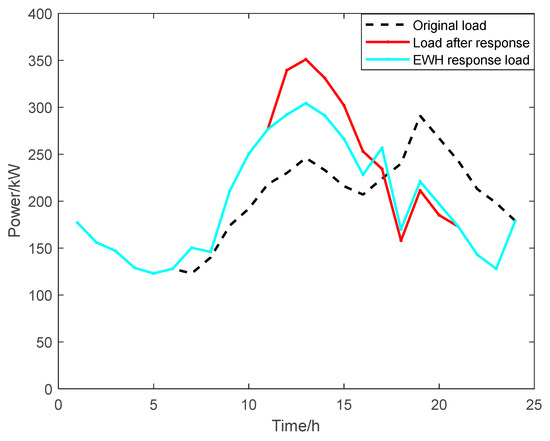
Figure 16.
Dispatching control results of EWH.
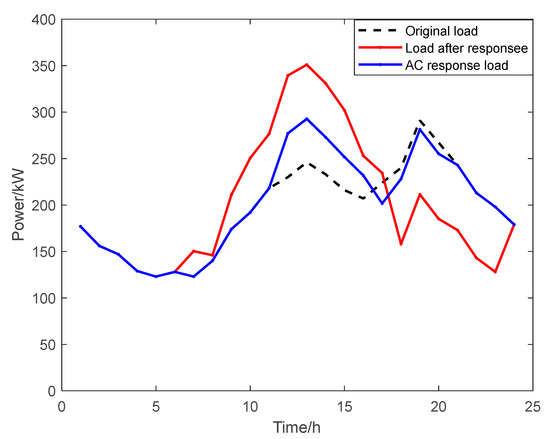
Figure 17.
Dispatching control results of residential AC.
It can be seen from above figures that there is redundant PV output in residential areas during the day in summer. Through coordinated DR of residential air conditioners and EWHs, PV can be consumed locally with greatest extent, which can not only bring “win-win” economic benefits to grid operators and users, but also reduce the operating cost of the power grid through “peak shaving and valley filling”, enhance the stability and flexibility of local distribution networks, and improve energy utilization efficiency.
According to above optimal operation results, the optimal incentives for different hourly periods of a day are shown in Figure 18. The figure shows that it is a positive incentive from 7 a.m. to 5 p.m. in the daytime, encouraging residents to use more temperature-control loads to consume the remaining PV; It is a negative incentive for periods from 6 p.m. to 11 p.m., and residents are encouraged to transfer or save electricity during the evening peak period.
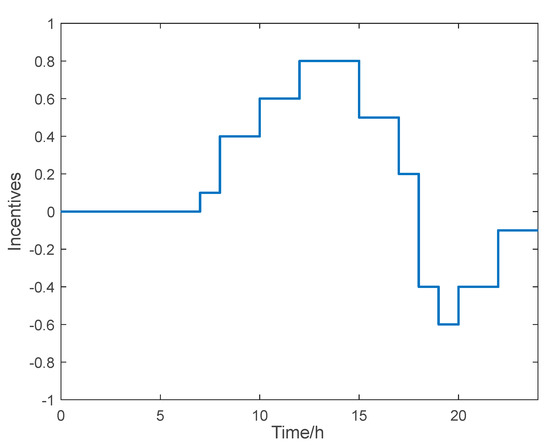
Figure 18.
Optimal incentives in different time periods.
The income of residential users comes from two parts: the income from distributed PV power sales and the income from DR incentives. The latter income is calculated by the difference between the total electricity expenses before and after the response. The initial residential electricity price is 0.4783 yuan/(), the incentives are shown in Figure 18, and the distributed PV electricity sales price is 0.35 yuan/(). After calculation, the net income of 200 households participating in DR is 1519.22 yuan per day.
The load aggregator purchases electric energy from the grid and users with distributed PVs and sells it to all the users who need electricity in the area. Through the flexible load DR, the electricity consumption is optimized to earn the difference of the intermediate electricity fee. After calculation, the net income of the load aggregator is 607.45 yuan. It can be seen from the above regulation results that both the load aggregator and the user have maximized their economic benefits.
4.4. Discussion
Before the regulation, the total normal power consumption of 200 households in the daytime is 1856 kW, and the PV consumption rate is 74.18%. By setting optimal incentive strategy after the grid operator perform the optimal operation of maximal PV power consumption, the total power consumption of 200 households in the daytime reaches 2460.72 kW, and the PV consumption rate reached 98.35%, with an increase of 24.71%. Due to the different response time scales of residential air conditioners and EWHs and their limited response potential, a small amount of redundant PV output occurs between 10 a.m. and 12 a.m. It is considered to promote solar energy storage type AC in residential areas. The application of energy storage type AC makes PV consumption more flexible and fully develops the DR potential of residential AC.
5. Conclusions
This paper focuses on the temperature-control loads of residential AC and EWH, studies the transfer and usage characteristics of loads under complex relationships, and deduces the optimal incentive strategy by optimal operation, so as to fully develop the potential of flexible loads and achieve the economic objective of photovoltaic maximum consumption.
Firstly, taking the AC load of residents as an example, a method combining ANP and fuzzy logic inference is proposed to predict the willingness of active load regulation. ANP is used to obtain main large impact factors as the inputs of fuzzy logic inference, through which the regulation willingness is deduced. Then, user sacrificed comfort temperature under different incentives are obtained according to survey. Furthermore, user maximal potential can be obtained through the ETP model. Multiplying user maximal potential with the willingness to regulate will get a probabilistic potential considered the uncertainty. The total power potential is obtained after superposing all probabilistic potentials to realize the optimal operation of maximal PV consumption. Correspondingly, the optimal incentives can be deduced. The optimal operation results show that the optimal incentive strategy proposed in this paper can not only increase the PV consumption ratio by 24.71%, that is, from 73.64% to 98.35%, but also achieve a win-win benefits for grid companies and users. It can be used as a reference for grid companies to formulate new energy consumption strategies.
The prediction model of a user’s willingness to respond established in this paper is deterministic, which requires that the fuzzy rule base in fuzzy logic inference is sufficiently large and the model needs to be revised regularly. Subsequently, an online adaptive neural network DR intention prediction model will be established. The self-learning function of the neural network and the self-renewal function of the online adaptive network are introduced so that the model can be automatically revised and updated according to the daily actual operation results, which can not only improve the prediction accuracy, but also save human and material resources.
Author Contributions
Project administration, Supervision, S.L.; Methodology, Writing—review & editing, T.L.; Writing—original draft, Investigation, X.Y.; Data curation, Formal analysis, S.Y. All authors have read and agreed to the published version of the manuscript.
Funding
The research is supported by the project of ‘Research on AI Interactive Technology of Regional Flexible Load for High Proportion Distributed New Energy Consumption’, sponsored by Beijing Electric Power Research Institute.
Data Availability Statement
Data provided by Beijing Electric Power Research Institute, US residential user load database and questionnaire in Beijing.
Conflicts of Interest
The authors declare no conflict of interest.
References
- Pathiravasam, C.; Venayagamoorthy, G.K. Distributed Demand Response Management for a Virtually Connected Community with Solar Power. IEEE Access 2022, 10, 8350–8362. [Google Scholar] [CrossRef]
- Xu, Q.; Ding, y.; Yan, Q. Research on Evaluation of Scheduling Potentials and Values on Large Consumers. Proc. CSEE 2017, 37, 6791–6800. [Google Scholar]
- Yang, Y.; Wang, T.; Chen, X. Multi-power level control strategy of an electric heating cluster considering new energy consumption. Power Syst. Prot. Control 2022, 50, 20–30. [Google Scholar]
- Qiu, G.; He, C.; Luo, Z. Economic dispatch of Stackelberg game in distribution network considering new energy consumption and uncertainty of demand response. Electr. Power Autom. Equip. 2021, 41, 66–72. [Google Scholar]
- Wang, J.; Chen, X.; Xie, J.; Xu, S.; Yu, K.; Gan, L. Control Strategies of Large-scale Residential AC Loads Participating in Demand Response Programs. CSEE J. Power Energy Syst. 2022, 8, 880–893. [Google Scholar]
- Montrose, R.S.; Gardner, J.F.; Satici, A.C. Centralized and Decentralized Optimal Control of Variable Speed Heat Pumps. Energies 2021, 14, 4012. [Google Scholar] [CrossRef]
- Xia, S.; Ding, Z.; Du, T.; Zhang, D.; Shahidehpour, M.; Ding, T. Multitime Scale Coordinated Scheduling for the Combined System of Wind Power, Photovoltaic, Thermal Generator, Hydro Pumped Storage, and Batteries. IEEE Trans. Ind. Appl. 2020, 56, 2227–2237. [Google Scholar] [CrossRef]
- Zhang, J.; Jiang, F.; Wu, H. Dual market bidding strategy of load aggregator based on CVaR. Electr. Power Autom. Equip. 2020, 40, 153–158. [Google Scholar]
- Iftikhar, H.; Sarquis, E.; Branco, P.J.C. Why Can Simple Operation and Maintenance (O&M) Practices in Large-Scale Grid-Connected PV Power Plants Play a Key Role in Improving Its Energy Output? Energies 2021, 14, 3798. [Google Scholar]
- Ma, X.; Wang, G.; Zhu, S. Coordinated Day-Ahead Optimal Dispatch Considering Wind Power Consumption and the Benefits of Power Generation Group. Trans. China Electrotech. Soc. 2021, 36, 579–587. [Google Scholar]
- Yang, X.; Fu, G.; Liu, F. Potential Evaluation and Control Strategy of AC Load Aggregation Response Considering Multiple Factors. Power Syst. Technol. 2022, 46, 699–708. [Google Scholar]
- Zhu, Y.; Wang, J.; Cao, X. Direct control strategy of central air-conditioning load and its schedulable potential evaluation. Electr. Power Autom. Equip. 2018, 38, 227–234. [Google Scholar]
- Sun, Y.; Liu, D.; Cui, X. Equal gradient iterative learning incentive strategy for accurate demand response of resident users. Power Syst. Technol. 2019, 43, 3597–3605. [Google Scholar]
- Li, W.; Wang, Q.; Zhang, H. Research on Counter measures to solve the problem of abandoned wind power: Based on the theory of price regulation mechanism and case analysis. Price Theory Pract. 2013, 2, 53–54. [Google Scholar]
- Li, W.; Yang, Q.; Zhang, H. Incentive mechanism research on accommodation of wind power in regional electricity market based on cooperative game. Renew. Energy Resour. 2014, 32, 475–480. [Google Scholar]
- Zhou, J.; Su, X.; Qian, H. Risk Assessment on Offshore Photovoltaic Power Generation Projects in China Using D Numbers and ANP. IEEE Access 2020, 8, 144704–144717. [Google Scholar] [CrossRef]
- Lan, L.T.H.; Tuan, T.M.; Ngan, T.T.; Giang, N.L.; Ngoc, V.T.N.; Van Hai, P. A New Complex Fuzzy Inference System with Fuzzy Knowledge Graph and Extensions in Decision Making. IEEE Access 2020, 8, 164899–164921. [Google Scholar]
- Yang, M.; Wang, Y.; Gao, S.; Zhang, Q.; Li, Z.; Wang, D. A bidding model for virtual power plants to participate in demand response in the new power market environment. In Proceedings of the 2021 International Conference on Power System Technology (POWERCON), Haikou, China, 8–9 December 2021. [Google Scholar]
- Zheng, S. Incentive-Based Integrated Demand Response for Multiple Energy Carriers Considering Behavioral Coupling Effect of Consumers. IEEE Trans. Smart Grid 2020, 11, 3231–3245. [Google Scholar] [CrossRef]
- Jia, Q.; Chen, S.; Yan, Z.; Li, Y. Optimal Incentive Strategy in Cloud-Edge Integrated Demand Response Framework for Residential AC Loads. IEEE Trans. Cloud Comput. 2022, 10, 31–42. [Google Scholar] [CrossRef]
- Huo, M.; Chen, L.; Niu, Z. AC Load Demand Response Strategy for Distributed Photovoltaic Power Accommodation. Power Energy 2021, 42, 313–319. [Google Scholar]
- Yang, Z.; Ding, X.; Lu, X. Inverter air conditioner load modeling and operational control for demand response. Power Syst. Prot. Control 2021, 49, 132–140. [Google Scholar]
- Wu, C.; Shen, H.; Wang, Z. Data-driven Online Identification Method for Parameters of Inverter Air-conditioning Load Model. Autom. Electr. Power Syst. 2022, 46, 120–129. [Google Scholar]
Publisher’s Note: MDPI stays neutral with regard to jurisdictional claims in published maps and institutional affiliations. |
© 2022 by the authors. Licensee MDPI, Basel, Switzerland. This article is an open access article distributed under the terms and conditions of the Creative Commons Attribution (CC BY) license (https://creativecommons.org/licenses/by/4.0/).